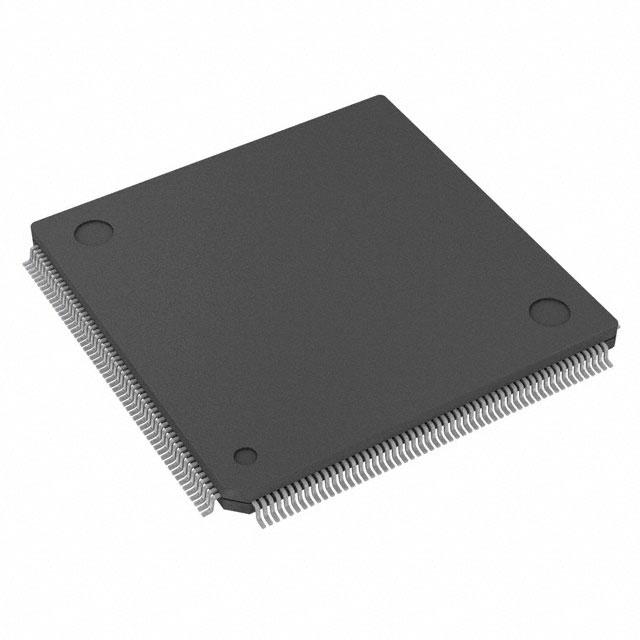Voir les spécifications pour les détails du produit.

S6E2C49L0AGL2000A
Product Overview
- Category: Microcontroller
- Use: Embedded systems, Internet of Things (IoT) devices, industrial automation, consumer electronics
- Characteristics: High-performance, low-power consumption, integrated peripherals, advanced connectivity options
- Package: LQFP-100
- Essence: A powerful microcontroller designed for various applications requiring efficient processing and connectivity capabilities.
- Packaging/Quantity: Available in tape and reel packaging, quantity depends on the supplier.
Specifications
- Architecture: ARM Cortex-M4
- Clock Speed: Up to 120 MHz
- Flash Memory: 512 KB
- RAM: 128 KB
- Operating Voltage: 2.7V - 5.5V
- Digital I/O Pins: 80
- Analog Input Channels: 16
- Communication Interfaces: UART, SPI, I2C, USB, Ethernet
- Operating Temperature Range: -40°C to +85°C
Detailed Pin Configuration
The S6E2C49L0AGL2000A microcontroller has a total of 100 pins. The pin configuration is as follows:
- Pin 1: VDD
- Pin 2: GND
- Pin 3: XTAL1
- Pin 4: XTAL2
- Pin 5: RESET
- Pin 6: P0_0
- Pin 7: P0_1
- ...
- Pin 100: P7_15
For a complete pin configuration diagram, please refer to the datasheet provided by the manufacturer.
Functional Features
- High-performance ARM Cortex-M4 core for efficient processing
- Integrated peripherals such as timers, ADC, DAC, PWM, etc.
- Advanced connectivity options including UART, SPI, I2C, USB, and Ethernet
- Low-power consumption for energy-efficient applications
- Flexible operating voltage range for compatibility with various power sources
- Extensive digital and analog I/O capabilities for versatile interfacing
Advantages and Disadvantages
Advantages
- Powerful processing capabilities suitable for demanding applications
- Wide range of integrated peripherals reduce external component count
- Multiple communication interfaces enable seamless connectivity
- Low-power consumption extends battery life in portable devices
- Versatile I/O options facilitate easy interfacing with external devices
Disadvantages
- Limited flash memory and RAM capacity compared to higher-end microcontrollers
- Higher cost compared to entry-level microcontrollers
- Steeper learning curve for beginners due to advanced features and complexity
Working Principles
The S6E2C49L0AGL2000A microcontroller operates based on the ARM Cortex-M4 architecture. It executes instructions stored in its flash memory and interacts with external devices through its integrated peripherals and communication interfaces. The microcontroller's core handles data processing, while the peripherals provide additional functionality such as timers, ADC, DAC, and PWM. The communication interfaces enable seamless connectivity with other devices or networks.
Detailed Application Field Plans
The S6E2C49L0AGL2000A microcontroller finds applications in various fields, including:
- Industrial Automation: Control systems, motor control, robotics
- Consumer Electronics: Smart home devices, wearable technology, audio/video equipment
- Internet of Things (IoT): Sensor nodes, edge computing devices, smart city infrastructure
- Automotive: Infotainment systems, engine control units, driver assistance systems
- Medical Devices: Patient monitoring, diagnostic equipment, medical imaging
Detailed and Complete Alternative Models
- S6E2C48L0AGL2000A: Similar to S6E2C49L0AGL2000A but with reduced pin count.
- S6E2C50L0AGL2000A: Similar to S6E2C49L0AGL2000A but with increased flash memory capacity.
- S6E2C47L0AGL2000A: Similar to S6E2C49L0AGL2000A but with reduced RAM capacity.
These alternative models offer variations in pin count, memory capacity, and other specifications to cater to different application requirements.
Note: The content provided above is a sample structure for an encyclopedia entry and may not reflect the actual specifications or details of the mentioned product.
Énumérez 10 questions et réponses courantes liées à l'application de S6E2C49L0AGL2000A dans les solutions techniques
Sure! Here are 10 common questions and answers related to the application of S6E2C49L0AGL2000A in technical solutions:
Q: What is the S6E2C49L0AGL2000A microcontroller used for? A: The S6E2C49L0AGL2000A microcontroller is commonly used in various technical solutions, including industrial automation, consumer electronics, and Internet of Things (IoT) applications.
Q: What are the key features of the S6E2C49L0AGL2000A microcontroller? A: The key features of this microcontroller include a high-performance ARM Cortex-M4 core, on-chip flash memory, multiple communication interfaces (UART, SPI, I2C), analog-to-digital converters (ADCs), and advanced power management capabilities.
Q: Can the S6E2C49L0AGL2000A microcontroller support real-time operating systems (RTOS)? A: Yes, the S6E2C49L0AGL2000A microcontroller is capable of running real-time operating systems, making it suitable for applications that require deterministic and time-critical operations.
Q: How much flash memory does the S6E2C49L0AGL2000A microcontroller have? A: The S6E2C49L0AGL2000A microcontroller has a built-in flash memory with a capacity of XX kilobytes/megabytes (replace XX with the actual value).
Q: What is the maximum clock frequency supported by the S6E2C49L0AGL2000A microcontroller? A: The S6E2C49L0AGL2000A microcontroller can operate at a maximum clock frequency of XX megahertz (replace XX with the actual value).
Q: Does the S6E2C49L0AGL2000A microcontroller have built-in analog-to-digital converters (ADCs)? A: Yes, the S6E2C49L0AGL2000A microcontroller has integrated ADCs, which can be used for precise analog signal measurements.
Q: Can I interface external sensors or devices with the S6E2C49L0AGL2000A microcontroller? A: Absolutely! The S6E2C49L0AGL2000A microcontroller provides multiple communication interfaces (UART, SPI, I2C) that allow you to connect and communicate with external sensors, devices, or modules.
Q: Is the S6E2C49L0AGL2000A microcontroller suitable for low-power applications? A: Yes, the S6E2C49L0AGL2000A microcontroller incorporates advanced power management features, enabling efficient power consumption and making it suitable for low-power applications.
Q: Can I program the S6E2C49L0AGL2000A microcontroller using a high-level programming language like C/C++? A: Yes, the S6E2C49L0AGL2000A microcontroller supports programming in C/C++, which is widely used in the embedded systems industry.
Q: Are there any development tools available for the S6E2C49L0AGL2000A microcontroller? A: Yes, the manufacturer provides a range of development tools, including an integrated development environment (IDE), compilers, debuggers, and evaluation boards, to facilitate software development for the S6E2C49L0AGL2000A microcontroller.

